It doesn’t matter if you’re a local brick-and-mortar business or an international advertiser—a solid geotargeting strategy as part of your digital marketing efforts is a must.
With geotargeting, you can hone in on the target audiences most valuable to you. You can also personalize your ads and landing pages with local references to create a custom experience for your users.
And once you start tracking campaign performances by location, you can find trends and segments that can boost your return on ad spend (ROAS).
That’s some serious power behind one simple location-based strategy.
In this article, we’ll cover everything from A to Z about geotargeting, including types of geotargeting, setting it up, and reviewing it.
We’ve also snuck in five awesome tips you can use to make your geotargeting strategy bulletproof.
Ready to get that geo strategy going?
- What is geotargeting?
- Why is geotargeting important?
- How does geotargeting work?
- 3 major types of geotargeting
- Geotargeting vs. geofencing
- Setting up & reviewing geotargeting
- Integrating geotargeting with your other targeting options
- 5 geotargeting tips & best practices
- Start setting up your geotargeting strategy
Get brand new PPC strategies straight to your inbox every week. 23,739 people already are!
What is geotargeting?
Geographic ad targeting (also known as “geotargeting,” or “geo” for short) is when an advertiser chooses a specific geographic location in the world where they want their pay-per-click (PPC) ads to appear.
This form of targeting appears in all of the major PPC platforms, including Google Ads, Facebook Ads, Microsoft Ads, LinkedIn Ads, and more.
The intent of geotargeting is to target people where they’re most likely to convert on your offer, increasing the return on your ad spend from your ad campaigns. That might be when they’re physically close to your business, or it may just be when they’re in a country that’s exhibited high conversion rates in the past.

Why is geotargeting important?
Geotargeting is a crucial tool in any PPC marketer’s toolbox for a few reasons.
- Location targeting is a huge factor in the mobile search market. At least half of all mobile searches seek local results, and 61% of those local searches lead to a conversion. So with mobile search already dominating the market, you can’t afford to miss out on this massive well of potential customers/clients.
- 88% of local search results lead to either a call or visit to a physical store within 24 hours. If you’re a local business, this is an excellent reason to line up a solid local geotargeting strategy.
- Geographic marketing campaigns give you more control over settings like language and ad scheduling, which can help you tap into your target market more effectively. For example, if you have one campaign targeting several countries, you can’t control your bidding for the time zones in those countries without geotargeting.
- Even if you’re targeting many countries or states, granular geotargeting can help you see which targets are winners and which ones are losers so that you can refine your target market. For example, if you target the U.S., you’ll never really get a clear picture of which states don’t convert but spend all your budget anyway—unless your geotargeting is broken out by state. So, if Tennessee is eating your ad spend but not converting, you’ll know to chop it off your targeting.
Wise geotargeting is essential for plenty of reasons, these four being the heaviest hitters.
Convinced yet that your marketing strategy needs a healthy dose of geotargeting?
How does geotargeting work?
According to Google (FYI, the other platforms basically work the same way), the real-time components for finding a user’s location for geotargeting can include
- IP address
- Wi-Fi
- Bluetooth
- cell tower IDs
- phone GPS
On the search side, determining a user’s location can be done by targeting keywords that mention a location or through custom location settings in campaigns (the latter arguably being more important).
3 major types of geotargeting
One of the fun aspects of geographic targeting is that it can be as broad or narrow as you want.
However, the word “geography” does imply that your targeting will remain on Earth. Sadly, there aren’t any colonies on Mars to show targeted ads to (yet). 😉
From largest to smallest, the below are the most common types of geotargeting.
1. Countries
The "country" level is the largest geotargeting audience you can use for your ads.
Even though this potential audience is enormous, you can still tailor your copy and content to your prospects.
If you’re selling products, for example, you can address the specific concerns of international audiences by highlighting benefits like worldwide shipping or 24-hour customer service support.
You can also tailor your ad content to reflect the dominant language of the country you’re targeting (if you’ve got a translator or native speaker on-hand).
For example, your ads may be more successful in France if your ads are written in French. (A word of caution, though: if you sell a service that relies on customer representative communication, it’s likely best to do this only if you have reps who also speak that language.)
2. Areas within countries
If country targeting is too broad for your needs, but you’re still trying to reach a large audience, there are multiple areas within counties or targeting options to choose from.
For example, Facebook Ads allows you to refine your geographic targeting by free trade area, sub-regions within a country like states or provinces, and other geolocations.
Similarly, most other ad platforms allow you to target regions, cities, states, ZIP codes, and even DMAs (Designated Market Areas).
3. Location radius
Radius or proximity targeting shows your ads to customers within a certain distance from a specific location (i.e., your business) rather than choosing individual cities, regions, or countries.
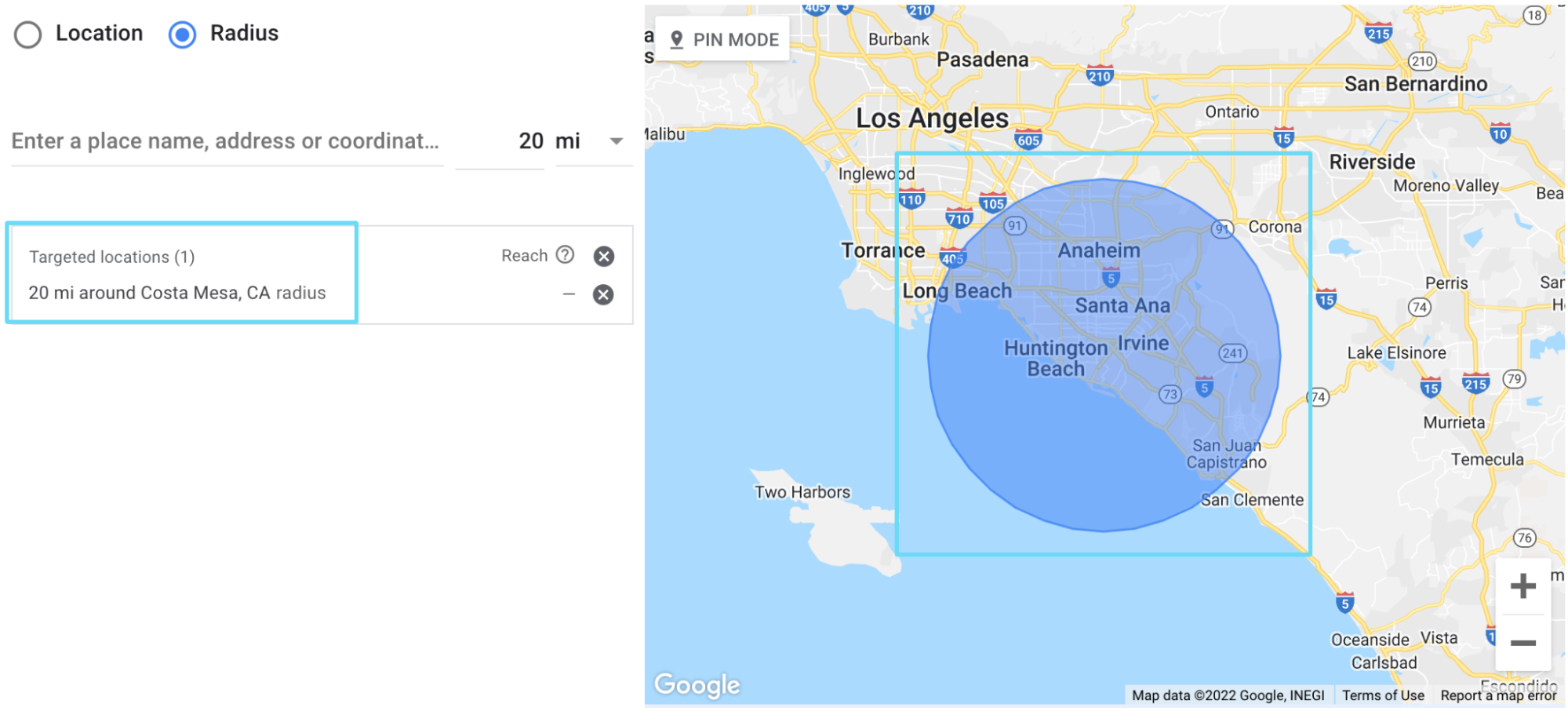
This form of geotargeting works best for driving foot traffic to a specific location or reaching potential customers within a defined delivery area.
While a tight targeting radius can help you reach high-intent customers in your immediate area, there are some drawbacks. The main disadvantage is that if there isn’t enough traffic in your area, your ads might appear rarely or not at all.
You’ll need to meet a minimum threshold of area traffic to take full advantage of your chosen PPC platform’s location targeting criteria.
Geotargeting vs. geofencing
When you start getting into the nitty-gritty of geotargeting, you’ll likely see another term pop up. This term is geofencing.
When talking to clients and other advertising professionals, this term will often surface. But it’s important to know that geotargeting and geofencing aren’t the same.
Geotargeting refers to targeting specific locations where you want your ads to show, as we mentioned earlier. Where we decide to geotarget is often (or at least should be) areas more likely to perform well for us based on that area’s past performance, demographic data, etc.
Geofencing, on the other hand, is the act of setting up an intentional targeting “perimeter” around a local area you want to corner the market on (i.e., a boundary line that, when people cross into it, they’ll start seeing your ads).
Radius targeting is an excellent way to describe geofencing. When you target a radius, you “fence in” all territory within that radius; when someone enters that radius, they’ll be shown your ads.
For example, a taxi company might geofence around an airport or train station to draw business from those immediate areas.
I’ve also seen some clients refer to geofencing specifically as a competitor-focused strategy, where they fence in around their competitor’s local turf in an attempt to steal business. While this isn’t the textbook definition of the term (and usually not an effective strategy), it is another possible way to geofence.
Setting up & reviewing geotargeting
Each PPC platform has its particular path for setting geographic targeting. We won’t cover them all here, but we’ll touch on the big two—Google Ads and Facebook Ads. Many other platforms will have a similar setup.
Geotargeting in Google Ads
In already-established campaigns, you can find Google Ads' geotargeting menu in your campaign settings under “Locations.”
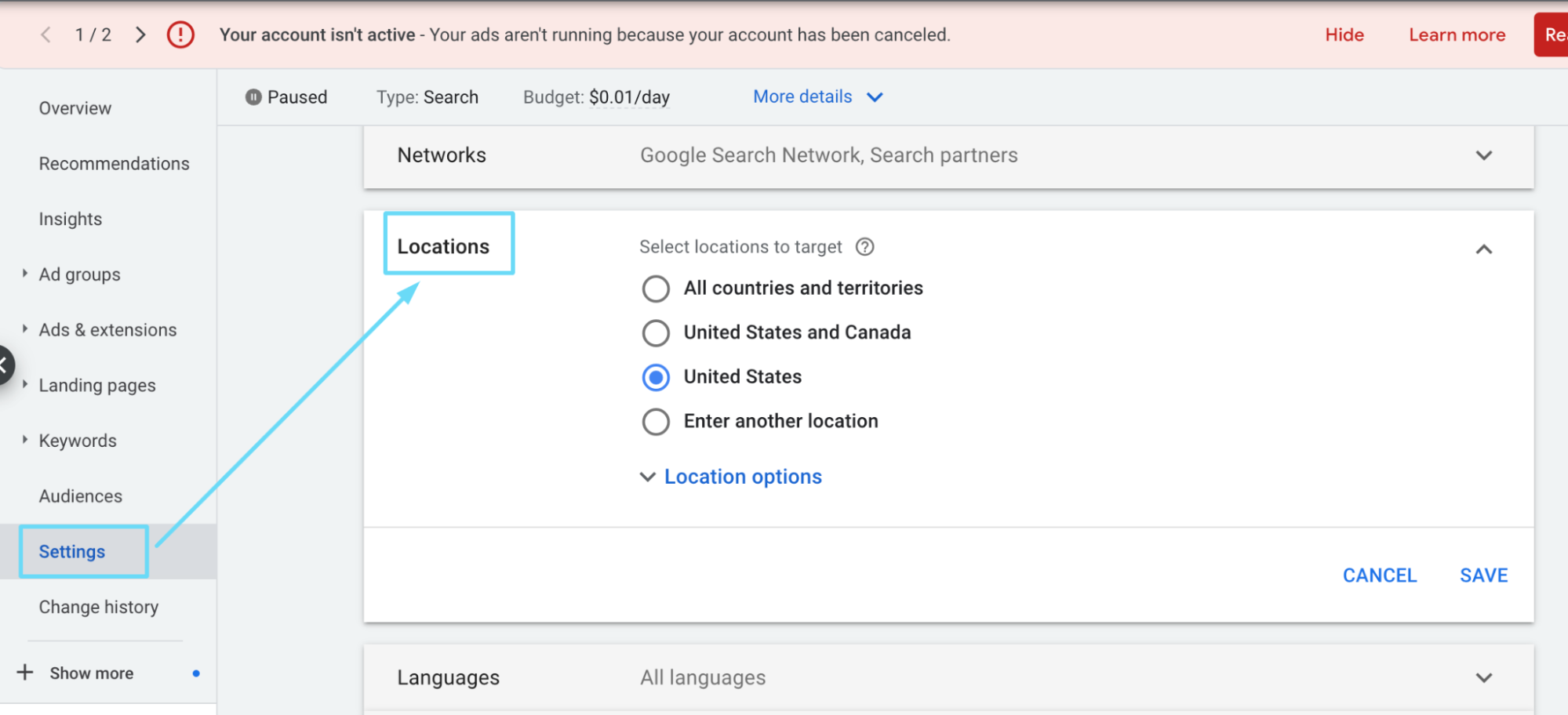
You have a few different pre-set options you can choose from. You can choose between all countries and territories, United States and Canada, or United States. If you want to target places besides these, or target radii, select “Enter another location.”
From there, you can quickly enter locations to target in the search bar, or you can go to “Advanced search” to open up a map.
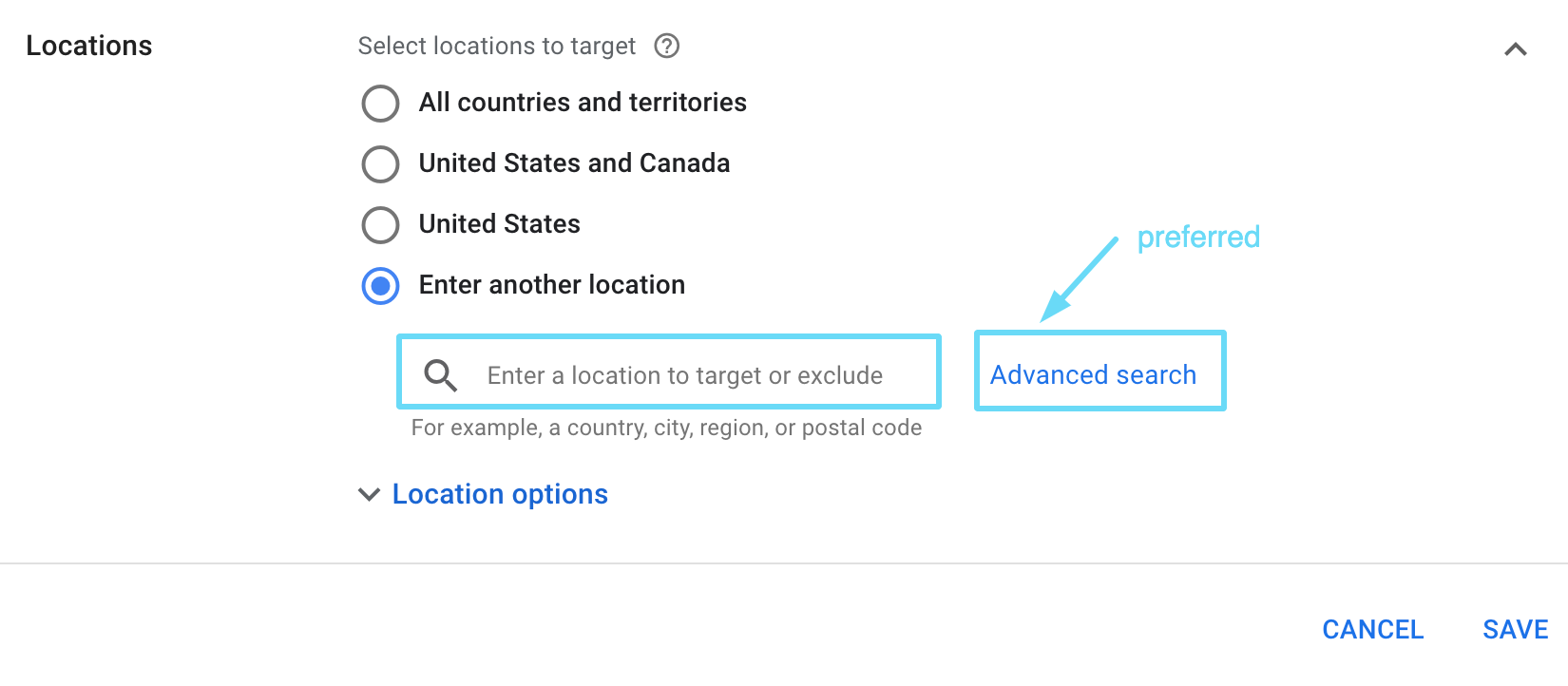
I prefer (and highly recommend) advanced search because you can see the locations you’re targeting on the map. You can also add radii or bulk locations.
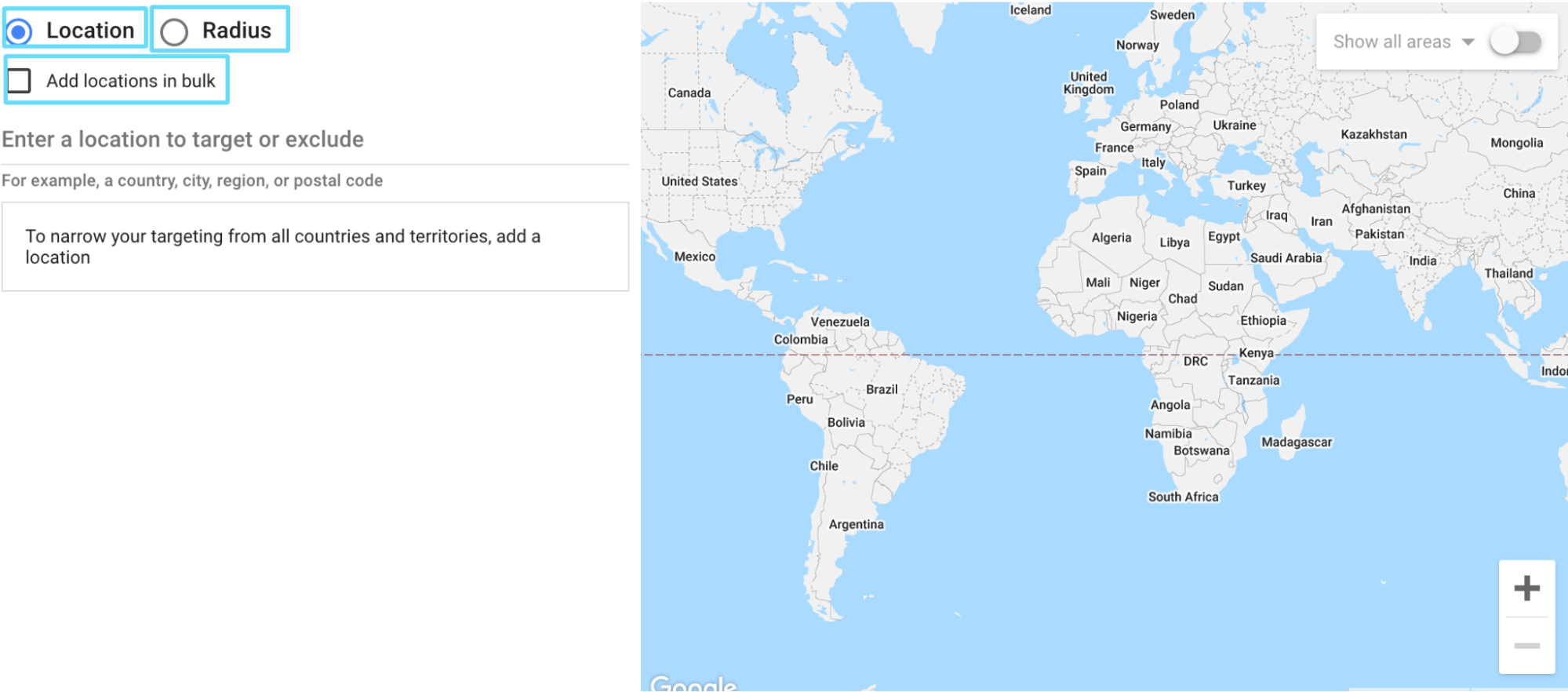
Another pro tip: Click on “Location options” within your campaign settings to decide the specifics of who you want to see your ads.

You can decide to show ads only to people in or regularly in your targeted locations (which we recommend, especially for local campaigns. Sorry, Google).
You can also decide to show ads to people who are either in your target locations or who simply show interest in them (but be aware that someone in France could show interest in California).
Lastly, you can show ads only to people who search for your targeted locations. (This is likely more useful for the travel industry.)
Geotargeting in Facebook Ads
To set location targeting directly from Facebook Ads Manager, follow these steps:
1. Within your ad set edit window, scroll down to “Locations.”
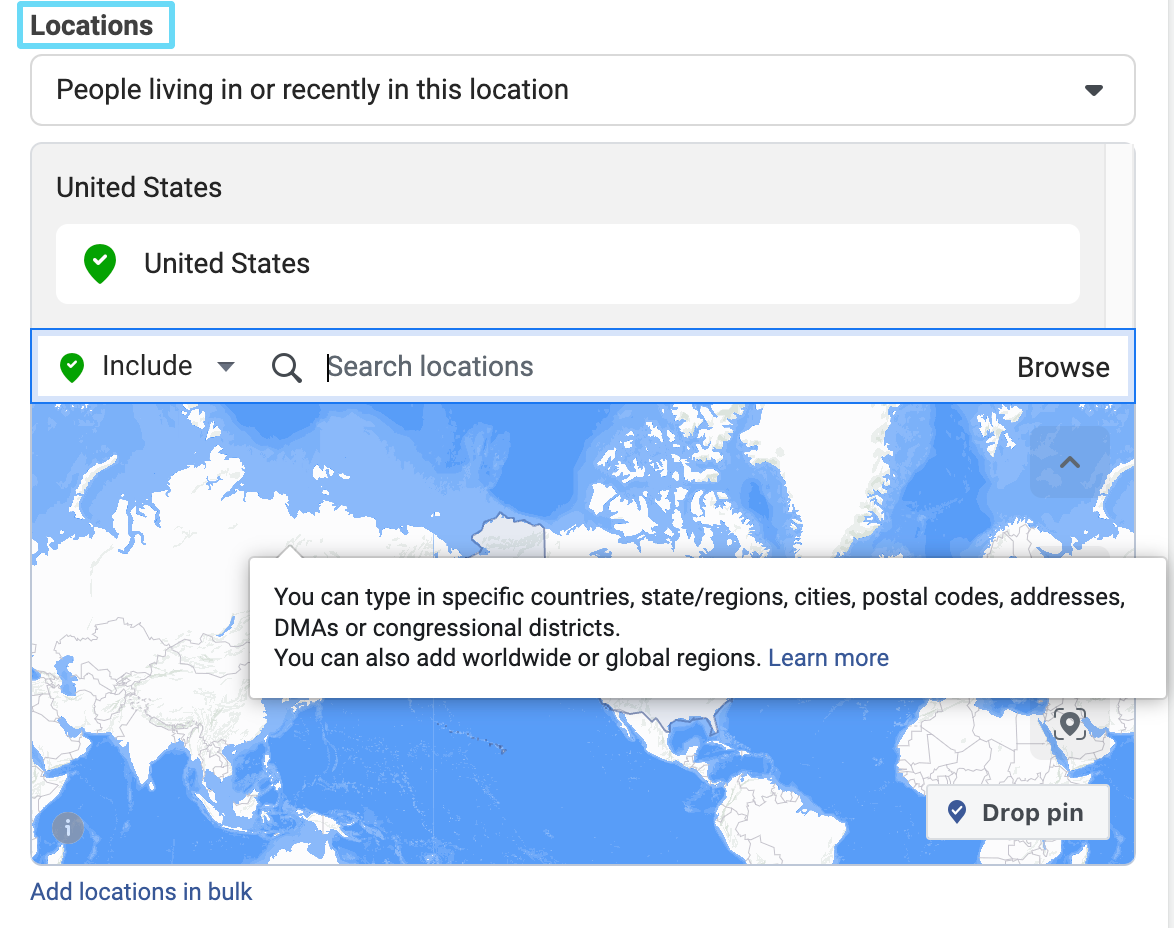
2. Either search for your desired locations to add them to your targeting or click “Browse” to browse locations and regions you’d like to add.
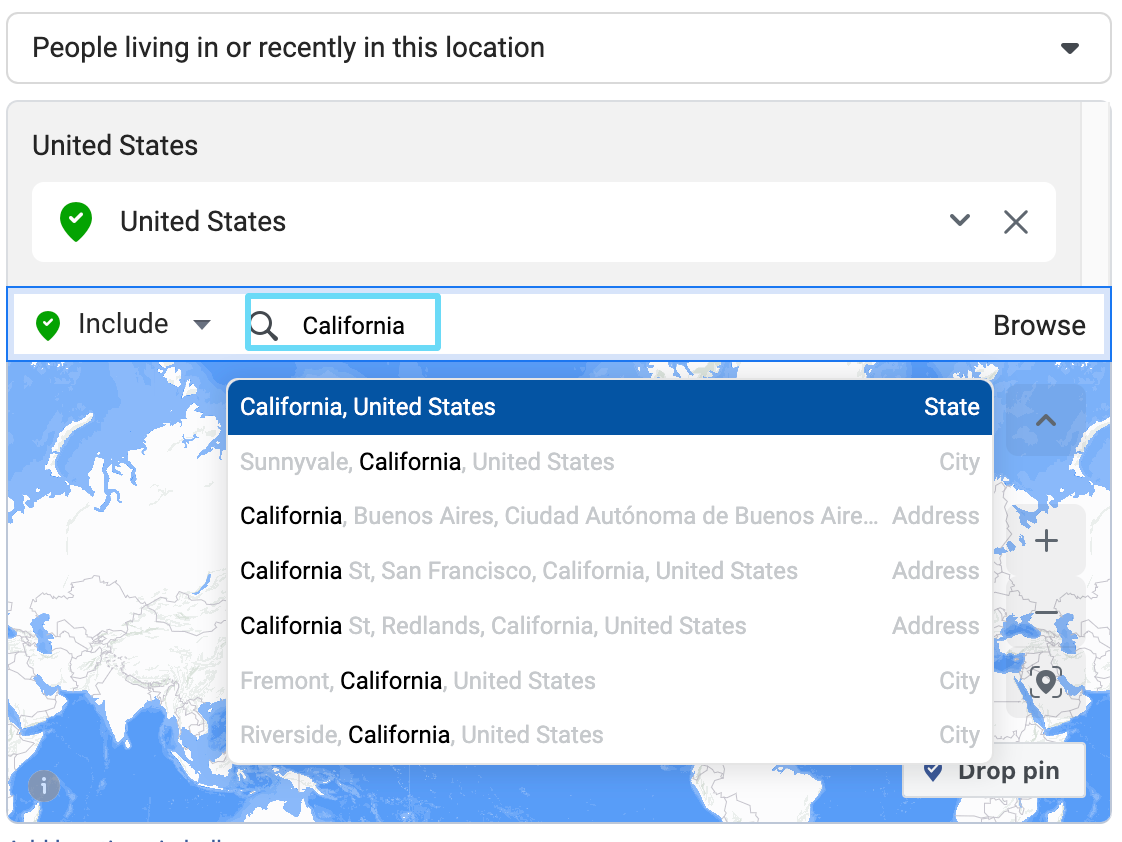
FYI, any cities you add to your targeting will be automatically added with a radius around them. To adjust this, click the dropdown next to your added location and change the radius or select “Current city only.”
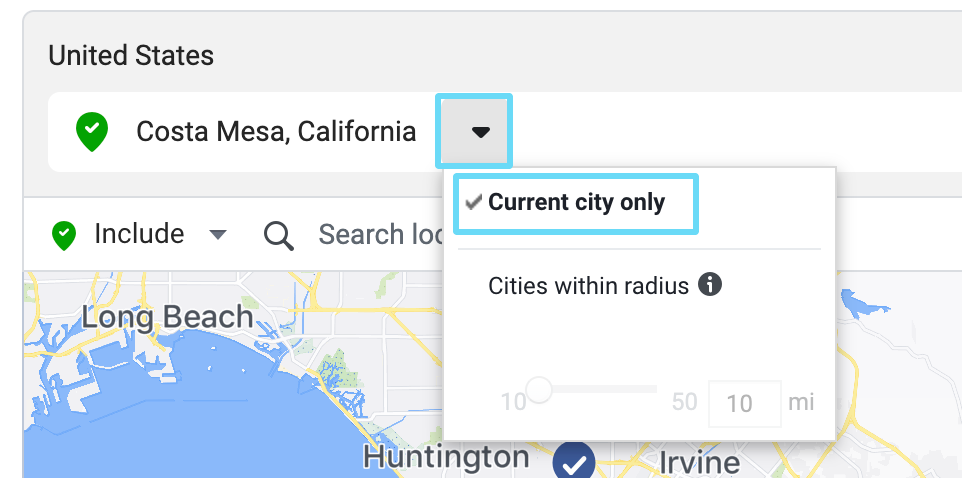
3. If you want to target a radius anywhere on the map, click the “Drop pin” button and click anywhere on the map.
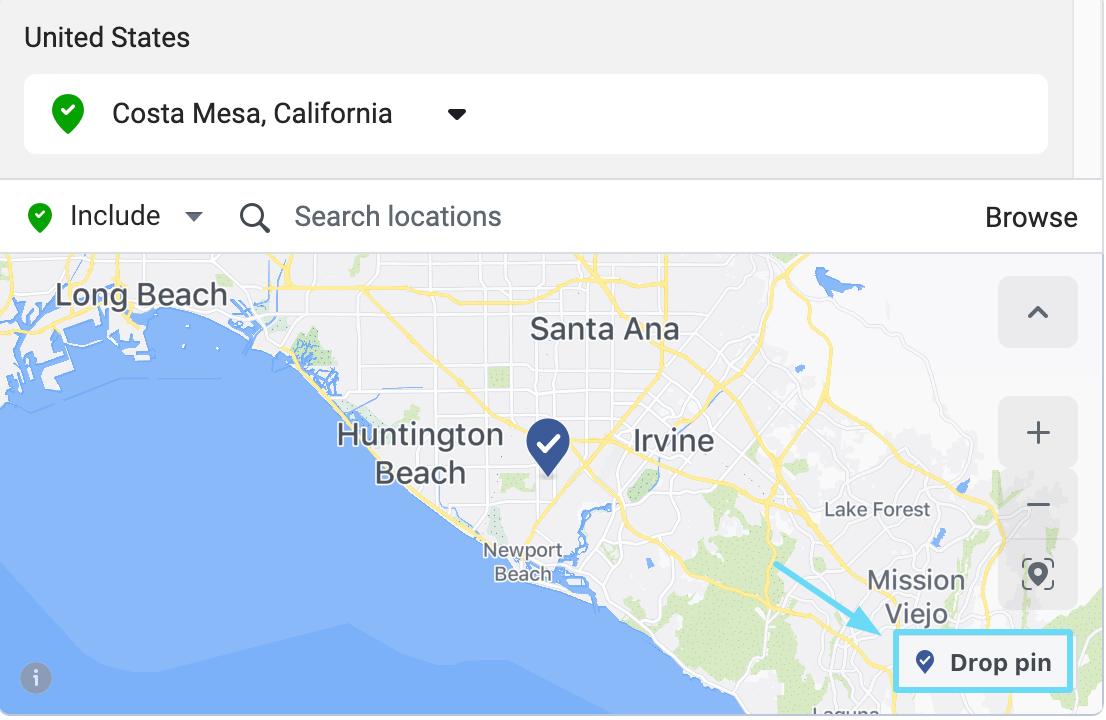
Reviewing your performance by location
If you have active PPC campaigns, your existing account metrics should include where your ads appear and how they perform by location.
You can use this information to then find more potential customers by adjusting your bids according to geographic performance.
For example, let’s say your conversion volume is much higher in the United States, like in the screenshot below, but you have your bid adjustments heavier in Australia right now.

If this is the case, you may want to add a higher positive bid modifier to the U.S. and reduce your bid modifier on Australia.
You can also, for example, create new campaigns with state-level campaign targeting if you see that some U.S. states’ CPA performance is much lower than others.
And if you need to get really granular, you can break down each state-focused campaign into multiple counties or cities to see if one performs better and break down your campaigns further from there.
That’s a little over-granular for our tastes (and for most budgets), but hey, if the data supports doing it, and you have the budget, why not?
Integrating geotargeting with your other targeting options
As we’ve already mentioned, geographic targeting in PPC isn’t an exclusive “either/or” proposition. It’s quite the opposite, in fact.
Location targeting is most effective if you use it with other targeting options.
The platforms mentioned above typically incorporate elements like demographics, search intent, interests, and devices (like mobile devices versus desktop or tablet) used in addition to location targeting when placing your ads. And in the right circumstances, geotargeting can even make retargeting campaigns more effective.
And if all that isn’t enough, once your ads start appearing to users, you can review location data and adjust your targeting, bidding, and even bid adjustments to improve your campaigns.
5 geotargeting tips & best practices
We’ve covered how location targeting can help your PPC campaigns, which is good to know. But what are the best ways to use location targeting effectively?
Here are some ideas that will give your geotargeting-based ads the best chance of generating a conversion.
1. Use local signifiers wherever possible
If you’re targeting local markets, you can use code to personalize your ad copy further and increase the likelihood of a conversion.
For example, you can use dynamic keyword insertion both in your Google Ads and in your landing pages to seamlessly include the names of locations included in your keywords for higher conversion rate opportunities.
Or, if you’re not using location-focused keywords, you can still
- create granular location-focused campaigns
- manually customize the ad copy to include the right message, including the location
- manually customize unique landing pages that reference the locations
Similarly, using a phone number with a geographically-specific area code for your ads and landing pages can reinforce the impression that you’re local—even if you’re not. And people are much more likely to call a local number than a toll-free number.
In our experience, this tactic can create a significant bump in generating phone leads.
This tactic can go even further when you're writing your ad copy. If you’re advertising at the local level, it’s important to “sound local.” So make sure you’re using local jargon, relevant content, and references for the locations or offers you’re emphasizing.
It may be a simple one, but the clearest example I can think of off the top of my head is using “Frisco” in a local ad to generate memberships for a new San Francisco-based gym. That wouldn’t go over so well with the locals.
2. Optimize ads for store-open and high-traffic hours
Location-specific ads often go hand-in-hand with brick-and-mortar stores. Lots of advertisers are trying to drive foot traffic to a physical location via paid traffic on Google’s search results page.
Don’t just get location-specific; get time-specific, too. For example, if the store in question is open at certain hours of the day or days of the week, optimize your ad bids for those times. Or, better yet, don’t show local ads at all during times when you’re closed.
Here’s another idea: if you already draw a big lunch crowd but want more breakfast visitors, you can also increase your bids earlier in the day to reach more users. (This is often called dayparting, and you can read all about how it works in our blog.)
Once you’re comfortable with the results of your bid adjustments, you can even use scripts to automate the process.
3. Test campaign changes locally before scaling up
Using geotargeting to segment your campaigns also lets you test new ad or campaign elements (new copy, exclusive deals, etc.) on a limited scale.
If you’re unsure how a new campaign will perform, you can limit its launch to a few specific markets to see how it does before expanding your reach.
4. Double-check your locations
Did you know that there are more than 50 different places in the U.S. named “Washington”? Or what about more than 30 different places named “Springfield”?
This might seem super basic, but you must ensure that the locations your ads are targeting are the right ones.
As the examples above show, just because you have the city name right doesn’t mean you have the correct location.
This is why I like to expand “advanced targeting” so that I can see the map when setting up geotargeting in Google Ads; it simply helps me verify that the locations I’m targeting are correct.
Trust me. You don’t want to spend $2,000 on the wrong Springfield and find out after the fact.
5. Exclude poor-performing areas
We mentioned earlier that you can use geographic targeting data to see how certain areas are performing within your larger targeting picture.
You can use that information to adjust your bids, but sometimes, for whatever reason, certain locations won’t respond well no matter what you do.
When that’s the case, you can exclude them from seeing your ads entirely and focus your budget on areas that are converting at a higher rate.
That’s a ‘micro’ example of using exclusions, but there’s a ‘macro’ version worth noting as well.
Let’s say you’re targeting a wide audience and showing ads in multiple countries, but your ads are only meant for English-speaking markets. You can exclude countries or cities where English isn’t the primary language to avoid wasting ad budget on traffic that won’t convert.
Or, let’s say you’re targeting California with your Google Ads campaigns, but you know that LA county historically doesn’t convert. Instead of breaking out your California targeting by county and excluding LA (which would take more time), you can simply target California but add LA county to your exclusions list.
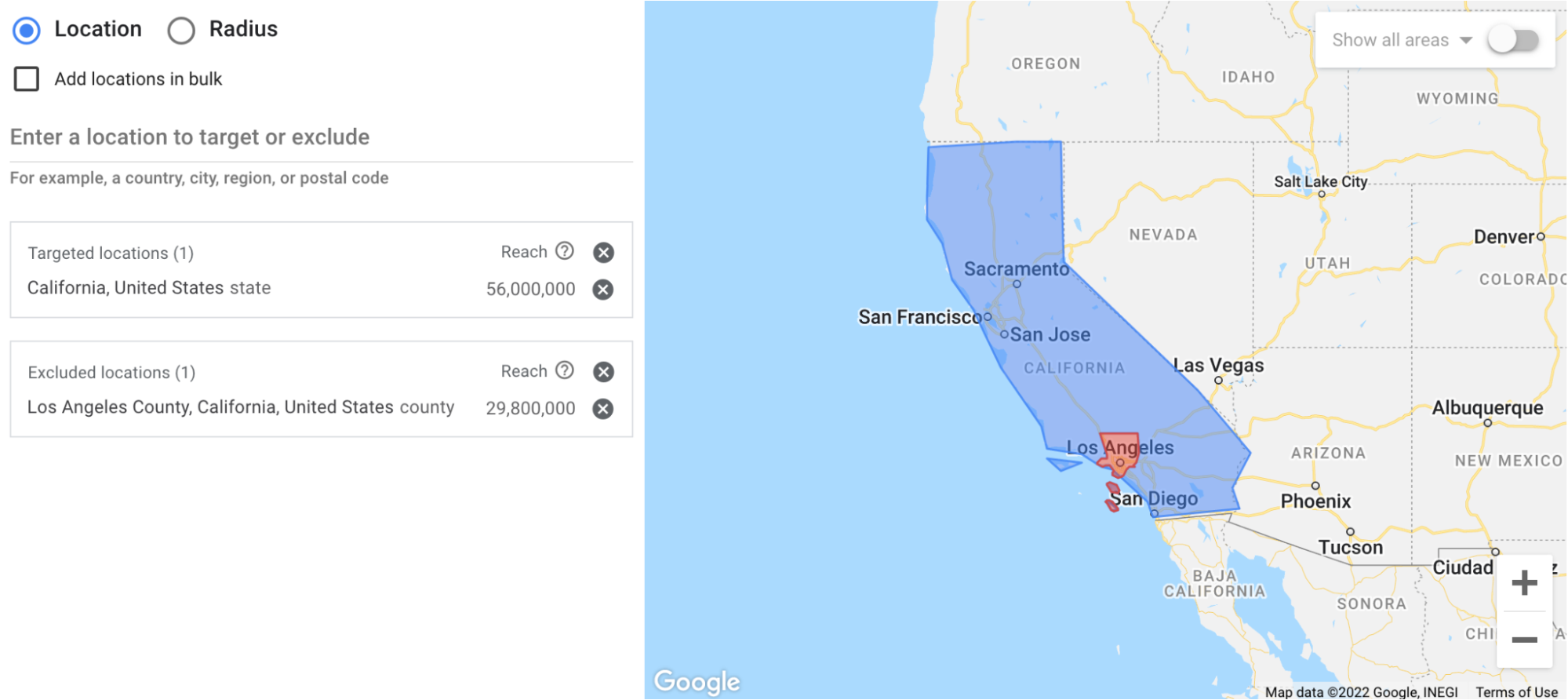
Start setting up your geotargeting strategy
The details can get complicated, but the ultimate goal of location-targeting is simple: it’s to increase your ROAS by showing your ads in places where your customers are likely to act and not showing them in places that they won't.
If you can remain mindful of that, your campaigns are in a much better position.
You’ve got every nugget of information you need to know to get started with geotargeting. You’re the expert on what it is, why it’s needed, and how to work it into your campaigns.
Plus, you’ve also got those five handy tips for success. All that’s left now is to get going with it.
If you’re curious about how you can not only show your ads in the right place but also at the right time, now’s a good time to head to our next article on dayparting.
Otherwise, set up your geotargeting for success and see where it takes you.